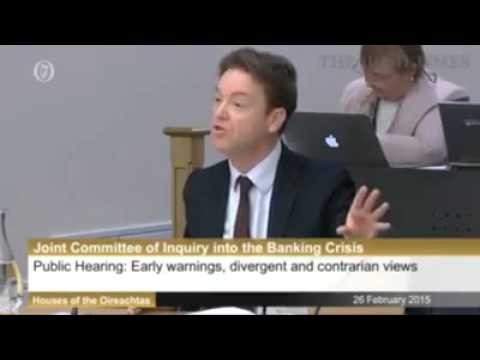Were the Mortgage Crisis and Bank Bailout Preventable
Post on: 16 Март, 2015 No Comment

(Credit: David McNew/Getty Images).
Signs of the subprime mortgage crisis first appeared by November 2006, when the Commerce Department reported that new home permits dropped 28% from the year before. This leading indicator predicted that new home closings would continue to be in a slump for at least the next nine months.
However, the Federal Reserve was still cautiously optimistic. According to the November Beige Book report, the Fed felt that strong employment, low inflation and increasing consumer spending would pull housing out of its slump by late spring.
Another clear sign of economic distress was the inverted yield curve. which also predicted the recessions of 2000, 1991, and 1981. An inverted yield curve is when short-term Treasury note yields are higher than long term yields. Usually, long-term yields are higher because investors want a better return for tying up their money for a longer time. However, if they believe the economy is slowing, they will prefer to invest in a long-term bond until the economy improves again. Economists ignored this sign because interest rates were still much lower than in prior recessions, and the economy had plenty of liquidity to fuel growth.
Most economists also thought that, as long as the Fed dropped the Fed funds rate by that summer, the housing decline would reverse itself, and the economy would still grow 2-3% that year.
True Cause of Crisis
In fact, 2007 GDP growth came in at 2%. However, what economy-watchers didn’t realize was that the sheer magnitude of the subprime mortgage market had created a perfect storm of bad events. First, banks were not as worried about the credit-worthiness of borrowers because they could sell the mortgages on the secondary market. Second, unregulated mortgage brokers made loans to people who weren’t qualified. Third, many homeowners took out interest-only loans to get lower monthly payments. As home prices declined and mortgage rates reset at a higher level, these homeowners could neither pay the mortgage nor sell their homes for a profit, and so they defaulted.
Fourth, and probably most importantly, mortgages were repackaged as mortgage-backed securities (MBS). Banks had hired sophisticated quant jocks who wrote computer programs that could repackage these MBS into high risk and low risk product bundles. The computer programs were so complicated that no one really understood what exactly was in each product bundle or how much of the bundle had subprime mortgages. When times were good, it didn’t matter, and everyone bought the high risk bundles because they gave a higher return. As the housing market declined, however, everyone knew that these products were losing value but, since no one other than the computer programs understood them, the resale value of the products was unclear.
Last but not least, many of the purchasers of these MBS were not just other banks, but individual investors. pension funds and hedge funds. This meant that the risk was spread throughout the economy. Furthermore, since hedge funds are not regulated by the SEC. they could use derivatives to borrow money to make investments. This created higher returns in a good market, and greater losses in a bad one, thus magnifying the impact of any downturn.
The Fed Intervenes
By March 2007, it appeared that these hedge fund housing losses could threaten the economy. Throughout the summer, banks became unwilling to lend to each other, afraid that they would receive bad MBS in return. No one knew how much bad debt they had on their books, and no one wanted to admit it. If they did, then their credit rating would be lowered, their stock price would fall, and they would be unable to raise more funds to stay in business. The stock market see-sawed throughout the summer, as market-watchers tried to figure out how bad things were.
By August, credit had become so tight that the Fed loaned banks $75 billion to restore liquidity long enough for the banks to write down their losses and get back to the business of loaning money. Instead, banks stopped lending to almost everybody. The vicious cycle was underway. As banks cut back on mortgages, housing prices fell further, which caused more borrowers to go into default, which increased the bad loans on banks’ books, which caused them to loan less.
Over the next eight months, the Fed lowered interest rates from 5.75% to 2%, and pumped billions of dollars into the banking system to restore liquidity. However, nothing could make the banks trust each other again. In November 2007, U.S. Treasury Secretary Henry Paulson realized it was a credibility problem, not a liquidity problem. He created a Superfund, using $75 billion in private sector dollars to purchase bad mortgages which were then guaranteed by the Treasury. But, by this time, it was too late as panic gripped the financial markets. and $75 billion was no longer enough.
An Ounce of Prevention
Two things could have prevented the crisis. The first would be regulation of mortgage brokers, who made the bad loans, and hedge funds, who used too much leverage. The second would be recognition early-on that it was a credibility problem, and that the government would have to buy the bad loans. If it had been done last year, the bill might have been less than $700 billion.
However, to some extent, the financial crisis was caused by financial innovation that outstripped human intellect. The potential impact of new products, like MBS and derivatives, were not understood even by the quant jocks who created them. Regulation could have softened by downturn by reducing some of the leverage, but it couldn’t have prevented the creation of new financial products, nor would you want it to. To some extent, fear and greed will always create bubbles, and innovation will always have an impact that is not understood until well after the fact.














